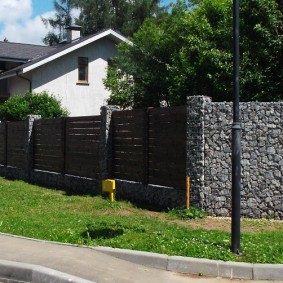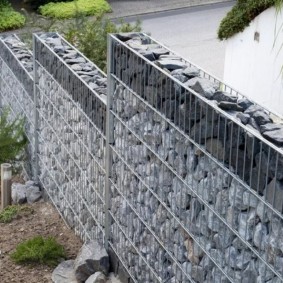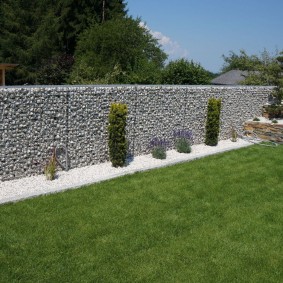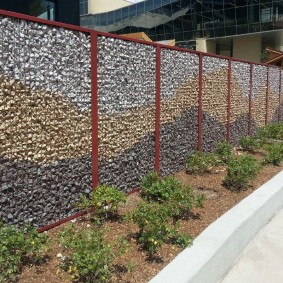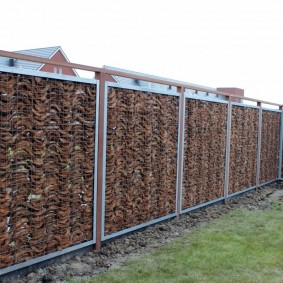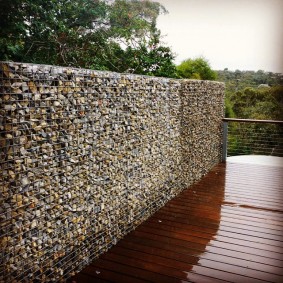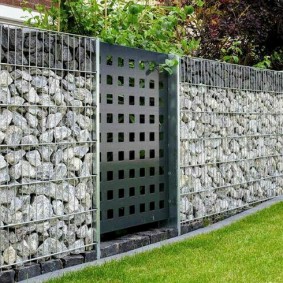 Landscape design
On the layout of the plot on 12 acres - landscape design options
Landscape design
On the layout of the plot on 12 acres - landscape design options
Fencing is an important element in the arrangement of a summer cottage. To build a fence of gabions means to give your estate originality and originality. Such a construction not only reliably hides the territory from prying eyes, but is also durable, economical in terms of material costs.
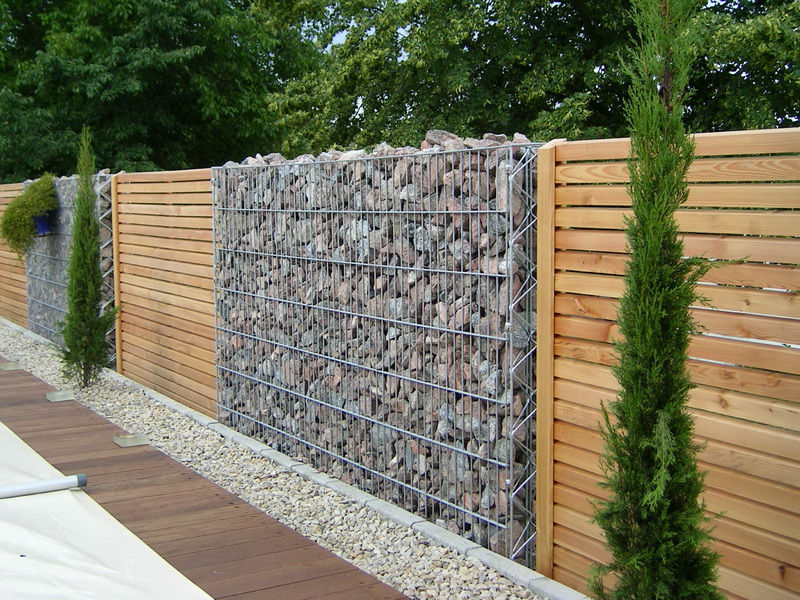
Currently, there are a variety of materials that can be used to create various fences.
Gabions in landscape design
Content
- Gabions in landscape design
- Gabion fence: advantages and features
- Types of Gabion Structures
- Technical characteristics of the gabion fence
- Why is a gabion fence the best solution for your site?
- Recommendations, photos of good examples
- Choosing the right stones
- Gabion net: material selection for the frame
- Conclusion
- VIDEO: How to make gabions with your own hands.
- 50 original design options for the gabion fence:
Gabion consists of two rows of galvanized wire mesh, the space between which is filled with stones, pebbles, gravel. Most often, box-mounted devices with a top are constructed. Such products are suitable not only for creating fences, garden "labyrinths", volume sculptures, but also for strengthening parts of an inclined area, reducing soil erosion, and strengthening the banks of water bodies.
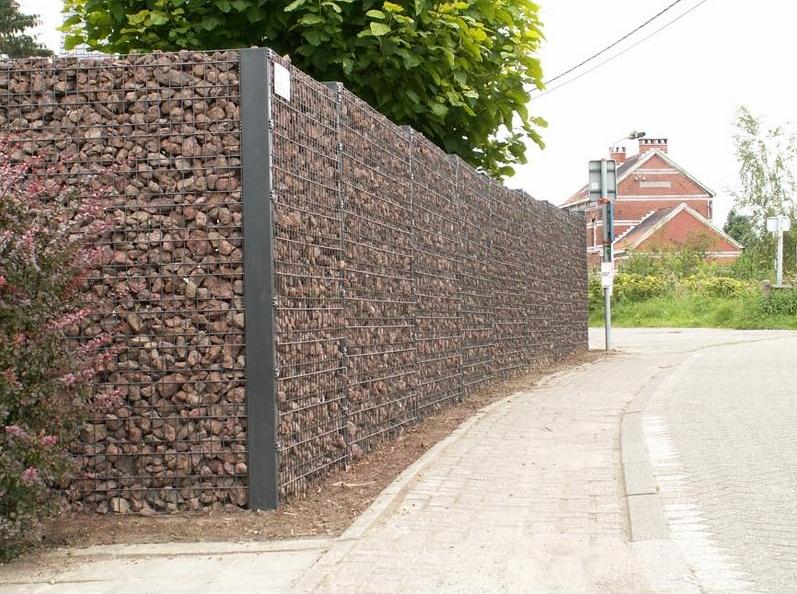
Many opt for options that are original, unusual.
Gabion fence: advantages and features
Modern gabion fences have many advantages:
- the design looks spectacular;
- the material is completely natural, natural, artificial mesh only;
- gabions easily reinforce the “spreading” slopes up to 12 meters high;
- the construction is inexpensive - the price is the cost of the grid, stones, installation work;
- the materials used allow you to make a high, medium or low fence.
But there are a number of minuses:
- the structure cannot be made thin - the “walls” will occupy part of the usable area of the site;
- it is very problematic to erect structures with a height of more than three meters;
- on "difficult" soils will have to prepare the foundation for such a fence.
Types of Gabion Structures
There are three main types of gabions:
- Boxed are wire containers in the form of a parallelepiped. Their sizes: height - 50-100 cm, width 100-200 cm, length - 200-600 cm. To increase strength, reinforcing diaphragms are inserted into the structure, at a distance from each other. Box gabions are made from a steel mesh having hexagonal cells and fixed to a rigid frame. In another embodiment, the grill is welded from galvanized wire, steel rods - this option comes out especially strong;
- Cylindrical - are made in the form of a cylinder, do not have stiffeners, therefore they are very flexible. The product has the form of a kind of “sausage” with a diameter of 60-95 cm, two to four meters long, with “tails” at the ends. Such gabions are made from double torsion mesh. Fences from them are rarely performed - an additional frame of thick reinforcement is required. When the elements are made of welded mesh, they are placed vertically;
- Mattress-mattress - suitable only for creating a fence, zoning structures located inside the territory of the site. Such gabions are almost flat, low - 20-50 cm high. (Most often 25 cm). The width of the product is 90-200 cm, the length is 150-600 cm. The main plus of the design is that it easily repeats any complex relief. Most often serves as the foundation for a box-shaped gabion fence or is installed on a hill.
Technical characteristics of the gabion fence
There are no particular restrictions in terms of the size of the gabion structure. The most popular options are 25-50 cm wide, one and a half to two meters high. The materials themselves (mesh, stones, geotextiles) are made and selected in accordance with current GOSTs and TU - documents regulate strength, wire torsion, mesh cell sizes, etc.

A fence made of gabions looks very interesting.
Why is a gabion fence the best solution for your site?
A properly executed gabion fence is a great idea for a fence of any size. With "age" the structure only becomes stronger - plants settle on it, fastening the stones with their roots. The fence looks solidly - it remotely resembles an ancient fortress. When doing the construction with your own hands, the fence will come out not at all expensive.

Do-it-yourself fencing with gabions is easy enough.
Recommendations, photos of good examples
In the photo there are fences made of small and large, flat and "curved" stones. Large elements are laid closer to the walls of the structure, small - in the middle. Designs look beautiful, where gabion posts are filled with stones of one color, spans - of another. On such a “wall” simple stone “drawings” are laid out - waves, suns, squares. The construction of gabion-boxes of rectangular shape is a great idea, especially if each "cell" is filled with different types of stones - a chessboard or even more complex pattern is obtained.

Choosing the right stones
Pebbles for fencing will fit almost any:
- granite;
- basalt;
- porphyrite;
- limestone;
- crystalline slate;
- trachytes;
- natural quartzite;
- tuff;
- sandstone.
It is important that the stones are frost-resistant, not fragile, in size - at least 30% larger than the size of the mesh cells, poorly absorb water. The most beautiful buildings are made of pebbles of approximately the same size and shape.

Such fences cannot be called familiar to most people, but they look very beautiful.
Tip: it is not advisable to use excessively large stones - large voids will turn out between them.
Gabion net: material selection for the frame
The frame is made of galvanized steel wire and metal poles. It is impossible to save on galvanizing - the strength and durability of the structure depend on it. Recommended coating density is 250 g. per square meter It is acceptable to use materials coated with an anti-corrosion layer or PVC. Wire parts are delivered to the construction site when folded, separately from the stones. The most suitable wire has a diameter of at least three mm., An additional six to eight mm thick steel bar is purchased.
Tip: it is unacceptable to have gaps in the wire, the connection by twisting, no more than one per 20 square meters m. is the norm.
Conclusion
Mounting a gabion fence is an excellent solution for many styles of landscape design. When properly executed, it is able to stand for more than a hundred years without losing integrity. Self-construction is quite possible after watching one of the workshops on creating gabion fences.

Today gabions are very unusual decorative elements.
VIDEO: How to make gabions with your own hands.



